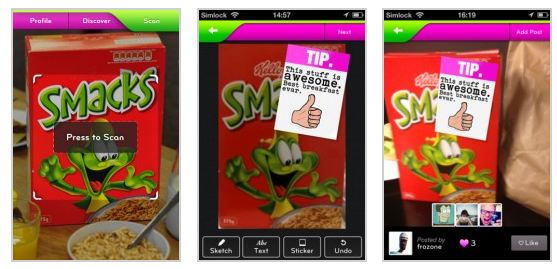Design your own reality with Stiktu
Recently, Dutch software-firm Layar introduced Stiktu, an application that lets users be creative with augmented reality. The app runs on iPhone and Android platforms and aims to be the next best thing in social media, blurring the boundaries between the social, the real, and the virtual. Although the app has only been launched worldwide since June, its concept of painting augmented spaces with digital graffiti is catching on rapidly. Moreover, its creators are trying to realize an admirable ideal: “With Stiktu we really put the power of augmented reality in the hands of the people.”
The functionality of Stiktu is simple, yet so delivering as it transforms our possibilities with augmented reality and enhances our world. In a nutshell, Stiktu could be described as followed: scan, edit, publish.
“So what? User-generated content isn’t anything new, yadda yadda yadda.” Maybe so, but the combination with augmented reality is trailblazing. Let’s have a closer look.
With Stiktu you can scan any object in the real world, be it a building, magazine or anything else with your smartphone camera. What follows is an editor that allows a personal touch by adding your own drawings, text or stickers to the object. When you’re all done and satisfied with your creation, hit publish and share your remix with the world.
Now this is where it gets interesting. Let’s say for example you’re done remixing that box of cereals you love or that famous statue in your city. When someone else scans that same object with their camera, they get to see your creation in real-time. No matter the angle of the camera, your creation remains on the exact same position on the object. Stiktu uses Layar’s Vision technology that allows it to link any scan with their existing database, so you don’t have to scan your object under the exact same circumstances as the original for it to detect a match. Pretty cool right? But it gets even better because Stiktu is not just a nifty camera app. By allowing your creations to be shared with the rest of the world, Stiktu is building a whole new social network where users can view, comment and like each other’s work. More importantly, when you scan an object that has already been remixed by multiple users, you get to see all the previous works by simply hitting the arrow buttons on your screen to browse back and forth.
Like many devices of augmented reality, Stiktu tries to bridge the gap between the virtual and the physical. Whereas virtual reality used to be a characteristic inherent to computerized worlds only, now it’s being domesticated into our daily environments. ((Manovich, Lev. 2006. The Poetics of Urban Media Surfaces. First Monday, 11, 2, <http://firstmonday.org/issues/special11_2/manovich/index.html>)) In general, Stiktu is the paragon of an ongoing socialization and meme-like transformation of augmented reality. Most early manifestations of personalized AR served commercial interests or have focused on specific purposes. ((Shaviro, Steven. 2007. Money for Nothing: Virtual Worlds and Virtual Economies. unpublished ms., http://www.shaviro.com/Othertexts/MMOs.pdf: p. 3-4)) The information they provided was coming from large institutions like Google (Maps) and Wikipedia, and users were mainly readers and not writers. Basically, these corporations had the controlling means of what you see and don’t see.

Source: Dmmediaplein.nl
With Stiktu this has changed. It provides the ability to add any information onto the digital meta-layer of reality. So, former readers become active writers within a collaborative participation-process that is generating a new view of reality. As in web 2.0 tendencies on the Internet itself, Stiktu increases the individual’s capacities for attributing to the virtual physicality, making him or her part of the design-processes that shape our augmented world.
Stiktu is not so much an information-based application as a creative platform that people can utilize to interact with each other. It is comparable to interactive storytelling, by which stories of individuals are being assembled and layered according to particular geolocations. What is remarkable about Stiktu’s content is that most of it seems to be based on meme-like animations – e.g. funny images with catchy captions – familiar with websites like 4chan and 9gag. In a sense, the cultural base of the Internet-meme is now being projected on physical reality by Stiktu.

Source: myandroidchief.net
Because of its user-generated nature, the democratizing elements of the application sound appealing overall, but keep in mind that applications like Stiktu can have detrimental consequences for our perceptions and personal relations as well. For instance, the democratization of virtual information in physical spaces can lead to a cluttered information overload. Also, if the app applies face-recognition software vigorously this could result in privacy violations. The notion of the ‘databody’ gets much more real when the individual could be traced according to his appearance and when digital information is unwillingly attached to his physiognomy by other users.
In the end, Stiktu is part of a tendency in which user-generated forms of augmented reality emerge. As it brings together the virtual and the physical, it is also extending online social networks to new spaces of physicality. Where this development will take us is uncertain, but it is without a doubt that our traditional notion of the physical environment is radically being altered as a result of new media applications like Stiktu. Although Stiktu’s concept is a step in the right direction to incorporate augmented reality with user-generated content that defines our current Web, it makes you wonder to what extent augmented reality will construct our perceptions in the future. Will the layers of augmented reality become mandatory in such a way that we no longer can perceive the world to its full potential without it? In fact, will augmented reality become our new reality?
P.S: For those of you who wish to try Stiktu, there is an easter-egg hidden somewhere on this page. See if you can find it ;)
Authors: Robert Silvis & Stijn van Wonderen
